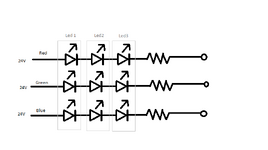ragav4456
Full Member level 4
RGB led (Amber color) on and off control with out microcontroller. Is it possible.
Input voltage is 24VDC.
Need to design a circuit when the 24V is received, the LED will turn on (Amber).
Any idea? Please help?
Input voltage is 24VDC.
Need to design a circuit when the 24V is received, the LED will turn on (Amber).
Any idea? Please help?
